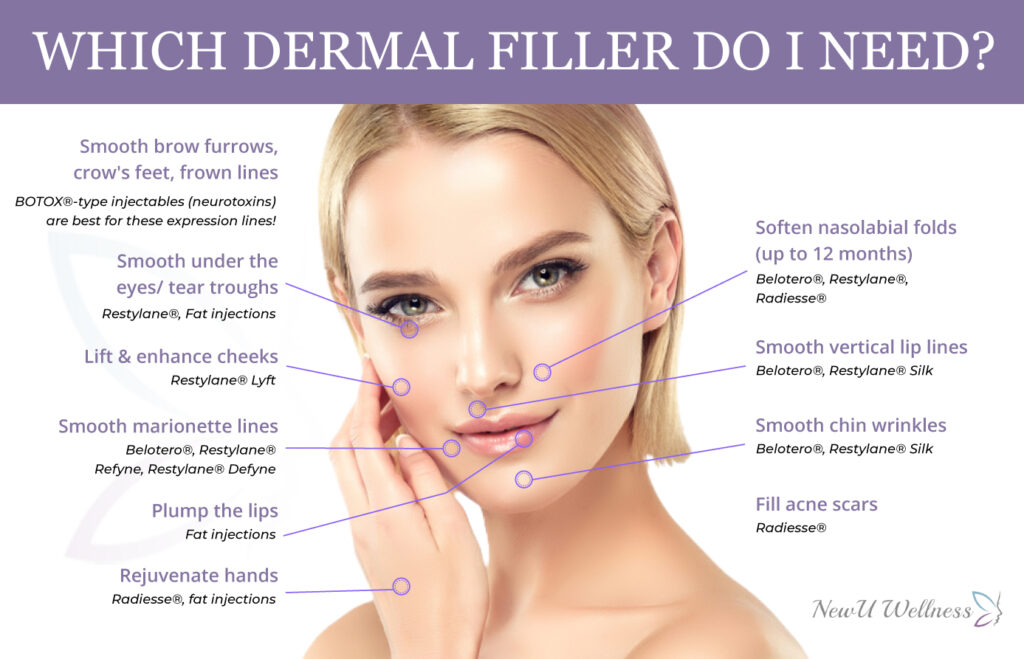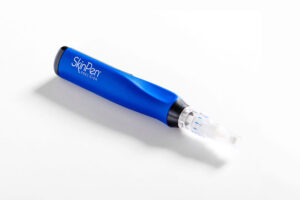Did you know that volume loss is responsible for many visible signs of aging? As facial tissues thin, lines form around the nose and mouth, and the cheeks appear hollow. Dermal fillers can help smooth wrinkles, plump the lips, and restore a more youthful appearance by replacing lost volume. Learn everything there is to know about injectable filler treatments here.
What are Injectable Dermal Fillers?
Dermal fillers sometimes called “wrinkle fillers’ are gel-like substances injected beneath the skin to restore lost volume, smooth lines and soften creases, or improve facial contours. This popular facial rejuvenation treatment is chosen by over 1 million men and women each year, and it can be a cost-effective way to look younger without surgery or downtime.
How Can Dermal Fillers Help Me Look Better?
They are capable of much more than simply smoothing out wrinkles, though they are excellent at this as well! Here are a few of the most common issues that dermal fillers can help with.
- Lines around the nose and mouth should be smoothed out (a.k.a. marionette lines, smile lines, and parentheses)
- Increase the volume of sunken cheeks or temples.
- Reduce the appearance of vertical lip lines.f sunken cheeks or temples.
- Lip plumping and enrichment
- Eliminate chin crease
- Improve the symmetry of facial features.
What are Fillers Made With?
Cosmetic surgeons use a variety of FDA-approved filler products. In general, fillers are classified according to the substance from which they are made. To ensure your safety, always seek FDA-approved, brand-name fillers, which are only available through a licensed physician.
1. Hyaluronic Acid (HA)
Hyaluronic acid is a naturally occurring compound found in the skin. It keeps skin hydrated and plump. HA fillers are typically soft and gel-like in texture. The effects are temporary, lasting 6 to 12 months or longer before the particles are gradually and naturally absorbed by the body. Most HA fillers contain lidocaine, which helps to reduce discomfort during and after treatment. Among the FDA-approved HA fillers are:
Restylane products:







Balotero Balance (+)

2. Calcium Hydroxylapatite (CaHA)
Calcium hydroxylapatite is a naturally occurring substance that is mostly found in our bones. Calcium particles are nearly microscopic and suspended in a smooth gel when used as a filler. CaHA fillers have a thicker consistency than hyaluronic acid fillers and typically last longer, about 12 months for most patients. Calcium hydroxylapatite, which is typically used for deeper lines and wrinkles, is also reported to help stimulate natural collagen production. Radiesse® is one of the FDA-approved CaHA fillers.

Choosing a Filler Treatment Provider
When choosing a provider for injectable treatments, practice the same caution and regulation that you would for a surgical procedure. Non-surgical filler treatment is still a medical procedure that necessitates specialized training, knowledge, and skill to ensure safe treatment and natural-looking outcomes. Choose a provider who has extensive knowledge of facial anatomy, a well-developed aesthetic eye, and the skill and precision of a surgeon.
Make sure whoever you choose has a proven background in cosmetic medicine, as well as training and significant experience performing filler injections. Inquire about before and after photos of a potential provider’s patients. If an R.N. or a physician’s assistant or nurse practitioner will be performing your injections, that person should be closely supervised by a qualified physician.
Which filler do I need?
With so many dermal filler products on the market, it can be difficult to know which one is right for you without the help of an experienced cosmetic surgeon. Because each product is uniquely formulated to have a specific texture, density, and injection depth, certain fillers work better for specific areas of concern. While your provider will determine which product is best for you, the diagram below shows where cosmetic surgeons typically apply certain products:

What to Expect During Treatment
Dermal filler injections are non-surgical procedures that are typically performed during an office visit. The first step in your treatment will be a consultation with your cosmetic surgeon to discuss your concerns and goals.
Pre-treatment consultation
Your doctor will evaluate your area of concern and review your medical history during your consultation. While the risks of dermal fillers are low, you must fully disclose your medical history before treatment because certain allergies, skin, and neurological conditions, or medications may jeopardize your safety or results. For example, if you have been taking NSAIDs (e.g., aspirin, ibuprofen, naproxen) or blood thinners, you must inform your cosmetic surgeon, as these increase the likelihood of bruising.
Your injectable filler treatment
The area will be cleaned just before the treatment, and you may be given a topical anesthetic to numb the area before injection. Many filler products also contain lidocaine, a mild anesthetic used to reduce discomfort during and after treatment. Your provider will then strategically inject a precise amount of filler beneath the skin.
You should be able to see results immediately after filler injections, depending on the product and the areas treated. Mild bruising and swelling may occur in some patients, but these are transient and should go away within a few days of treatment. You will be able to resume your normal activities immediately following treatment, but your cosmetic surgeon may request that you refrain from exercising or engaging in strenuous activity for the day.
How Long Do the Results Last?
The duration of the effects of dermal fillers is determined by the product, the area of treatment, and the patient. Although this is not a hard and fast rule, the denser the product and the deeper it is injected, the longer it will last. Your cosmetic surgeon will simply repeat treatment to maintain your results, adjusting the amount and techniques as needed to ensure optimal results.
Since hyaluronic acid fillers are the most temporary option, they are frequently recommended for first-time filler patients. These typically last between 6 and 18 months. Lip injections will last slightly longer than nasolabial fold injections.
Although synthetic fillers are not absorbed by the body, they last longer. They can be a great option for the right patient, but you should be prepared to commit to long-term results—and choose an experienced, qualified provider whose aesthetic style you like.
Find a qualified dermal filler provider near you
Injectable fillers can provide natural-looking enhancements to help you feel more confident in your appearance when used by an experienced, qualified provider. If you’re ready to learn more about your options, the next step is to schedule a consultation with a Nurse Practitioner.
QUICK FACTS
- Filler treatments are popular due to their immediate results, quick treatment, and little to no downtime.
- Depending on the product and treatment, the results can last 6 months to 2 years or longer.
- ABCS surgeons have completed fellowship training in injectable filler treatments.
Schedule a Dermal Filler Consultation
Schedule a consultation with NewU Wellness, so we can discuss treatment goals and develop a plan to address the areas that concern you. Call NewU Wellness at (239) 789-2184 or schedule an appointment online.







